Welcome to another edition of Willoughby Hills!
This newsletter explores topics like history, culture, work, urbanism, transportation, travel, agriculture, self-sufficiency, and more.
If you like what you’re reading, you can sign up for a free subscription to have this newsletter delivered to your inbox every Wednesday and Sunday and get my latest podcast episodes:
I am trying to use Twitter less these days, although a recent tweet stood out to me and it really sparked some memories. The tweet on the Bring a Trailer account linked to a listing for a 1984 Chevrolet Caprice Classic, which was very similar to the car my grandpa drove when I was young.

If you’re not familiar, Bring a Trailer is an auto auction site, similar to eBay. Cars are bought sight unseen, so it’s incumbent upon the seller to write descriptively and include as many photos as possible to help sway potential buyers into placing a bid. The listing for this particular Carprice Classic includes nearly 200 photos of just about every possible detail of the car.

On their face, the photos seem utilitarian, consciously more informative than evocative. I doubt that the photographer intended for the images of this car to be artistic in any way. Yet, with the state of smart phone cameras in 2023, it’s easy to make beautiful photos that make a statement, even if completely unintentionally simply because camera phones can now alter the depth of field and other settings to make some areas of the image appear crisp while others fade off in a blur.
As I looked through the photos of this car in this listing, I was suddenly a child again. The small details of the car which the photographer brought into focus conjured up specific memories of being a kid that I had long forgotten.
While my grandpa’s car was not identical to this one, it was close enough to still trigger nostalgic thoughts. His was silver in color and I believe a 1980 or 1981, but the important details were all pretty much the same.
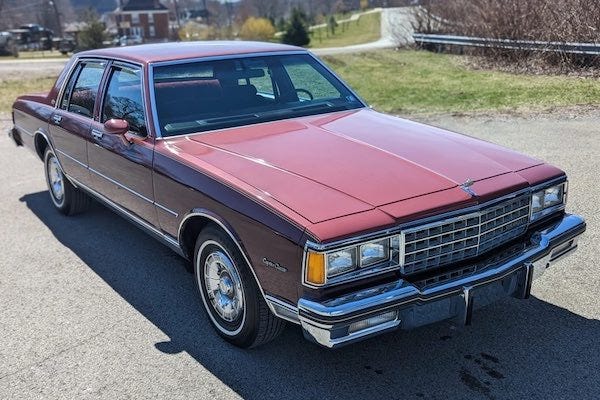
My grandpa was a huge presence in my life. He and my grandma lived about six houses down the street from us in a 1920s Sears house that they bought in the 1960s. He was over six feet tall and had a husky frame. As a kid growing up in the 1980s, he seemed like a giant to me, and he had a boat of a car to match his stature.
In my mind, this car is synonymous with my grandpa, although he didn’t exactly choose it to match his personality. It kind of just found its way to him. It was purchased brand new by my uncle’s father-in-law, who then sold it to my uncle. A few years after that, my uncle sold it to my grandpa and the car was with him for the next decade or so during my most formative years.

The front bench seat had seatbelts for three passengers. It was rare, but from time to time, I would ride in the middle seat up front and stare at the controls on the dash board. I remember the faux wood grain, watching the minutes on the analog clock roll over (it was especially exciting to see the tens or even the hour spot change too).
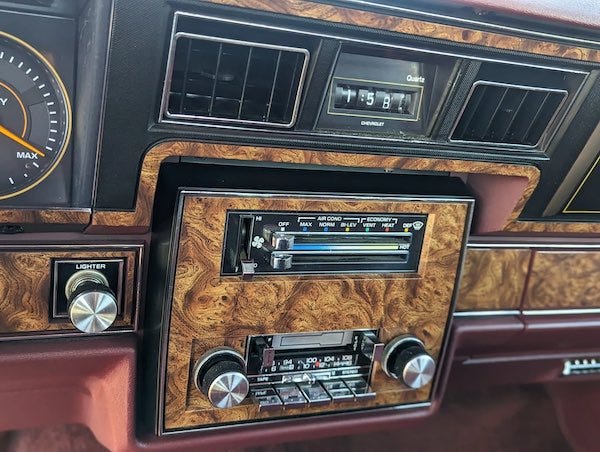
The radio on my grandpa’s car was also identical to the one in the listing, with an AM/FM tuner and a cassette deck. Most of my childhood, we were only in this car for a few minutes at a time, my grandpa taking us to McDonald’s or Old Country Buffet down the road for lunch. On those trips, the radio was almost always turned off.
But I can recall a few longer road trips in this car too, and at those times, my grandpa would play music that he liked from his vast tape collection. The music was almost always classical or pop standards from the 1940s by artists like Jo Stafford.
When music would play, I used to stare at this radio in disbelief. It was completely foreign to me compared to what was in my mom’s Toyota and I always wondered how he understood how to make it work. The buttons were giant and mechanical, barely anything was labelled, and that which did have a label seemed even more confusing. For example, the eject button was labelled as “EJCT.” As a child, I used to stare at that and wonder why they couldn’t find room to include one more letter to spell it properly, or maybe drop a letter to make it more clearly an abbreviation.

Seeing photos of the steering wheel and driver’s console brought back memories too. I can remember the keys in my grandpa’s hand as he unlocked the doors or started the car. My parents drove manual transmission cars with a center gear shift, so having an automatic with the gear shift on the column like this was also a novelty for me as a kid.
The Caprice Classic’s steering wheel was emblazoned with its own emblem featuring a fleur-de-lis which I always thought was the Chevy logo as a kid (even though I was also familiar with the standard “bow tie” logo). I only recently realized that emblem this was specific to this car (although the fleur-de-lis also made an appearance in Corvettes).

The fleur-de-lis emblem also appeared on a hood ornament, the side roof pillars, and the rear trunk, where it concealed a key hole to unlock the trunk. Watching my grandpa open the trunk to load up groceries felt like being alongside a superhero unlocking the entrance to his secret lair.
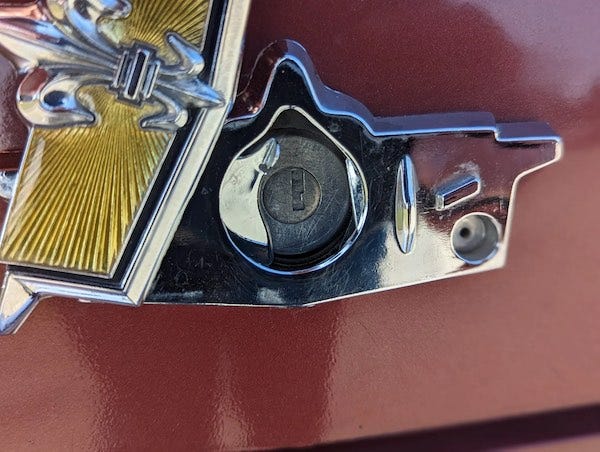
Another “secret agent” quirk of this car was how refueling worked. The rear license plate was hinged and when it was lowered, it would reveal the fill tube for the fuel tank. This meant that at gas stations, the refueling hose was placed in the rear center of the car rather than off to one side. This was done on other cars of the era, but both of my parents’ cars had standard side fuel doors, so this was quite strange to see for a youngster.

This car felt enormous to me as a kid, but the Caprice had actually been shrinking since its debut in 1966. The biggest downsize happened a few years before my grandpa’s car was manufactured and would inform his model too. According to Wikipedia:
“Launched in late September 1976, the 1977 Caprice Classic was drastically downsized, which reduced its weight and exterior dimensions, while increasing headroom, rear-seat legroom and trunk space compared to 1976 models. GM called its downsizing program Project 77 and invested $600 million to develop the most changed full-size Chevrolet to date. The weight reductions from the 1976 models were… 637 lb for sedans. …The 1977 Caprice coupe and sedan were over 10 inches shorter… Wheelbases were reduced to 116 inches from 121.5 inches for coupes and sedans.
Although by modern standards, the 1977 downsized Chevrolet cars are quite large, the new Chevrolet had exterior dimensions closer to the intermediates of its day… 1977 also marked the first model year in history that a midsized car, the Monte Carlo, was larger than a full-sized car… The introduction of a downsized full-size car was considered quite a risk for General Motors.”
The Caprice Classic was quite a popular car in its day. The downsized version that debuted for 1977 was the best selling car in America that year and was awarded car of the year by Motor Trend. In addition to being used by everyday Americans, it was also used as a police car and taxi during this time.

Yet for me, there was something about my grandpa’s car that made it feel old, exotic, and like nothing else I was used to. Perhaps this is because it was so different from anything else the adults around me were driving at the time.
My parents always drove Toyotas, which were much smaller than American cars in the 1980s. My mom’s Tercel station wagon was compact and had a four cylinder engine, a manual transmission, and barely any chrome to decorate its body. It was quite the contrast from the V8 Caprice Classic.
I suspect the oil crises of the 1970s changed my parents’ perceptions of what should be valued in a car. But I also think changes in the meaning of work and home may have played a factor in why my parents seemed to always opt for small and efficient and my grandpa went big.
For more than 30 years, my grandpa’s daily commute to work was about 4 miles one way, a trip which took just over 10 minutes to complete. The majority of the errands he ran, from grocery stores to doctors’ offices were within roughly that same radius. He would venture beyond that sphere only on rare occasions. My grandpa didn’t think much about the cost of fuel because he wasn’t buying that much of it. In fact, the Caprice only had a 5 digit odometer, meaning it couldn’t register if the car drove over 100,000 miles in its lifetime. I highly doubt that my grandpa came close to hitting that mileage.
By contrast, my mom, who lived six houses from the house she grew up in, worked 28 miles away from home, one way. Beyond that, we routinely would travel to other neighborhoods around Cleveland to try restaurants or shop. Even little necessities like her hair salon was 20 miles away.
When I think about my own commuting patterns these days, it’s even more absurd than that of my parents. My kids’ school is 14 miles from our house. My wife’s job is 24 miles and my office is currently 35 miles.
Some of this may be coincidental or anecdotal, but I do think there’s something in my family’s story that is representative of a larger societal shift. Housing costs have soared in my lifetime and in many major markets, finding an affordable place to live means being further from the big city. This is certainly the case for us in the Boston area and it contributes to my wife and my long commutes.
This shift to driving more could also be a function of a more specialized economy that tries to cater to more niche preferences. My grandpa chose to eat and shop locally not because they were the best options but because they were the available options. The very thought of liking a restaurant in another town was completely at odds with his personality. Why waste the time and gas to go somewhere else when there was a Dairy Queen right here?!
My mom chose to travel a little further because she valued her own preferences and was willing to seek them out, even if it cost more time and money. She was willing to travel to go to her favorite restaurant or visit a specific store. She could’ve gotten her hair cut closer to our house, but the stylist she liked happened to work at a salon that was further away.
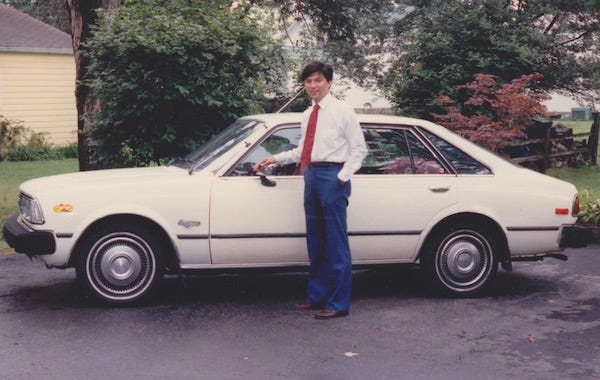
I feel like I have the same tendencies as my mom and they are even more pronounced. My kids go to school 14 miles from home not because there aren’t schools in our neighborhood. There are. But my wife and I choose to send our kids to a private school which more closely aligns with our educational goals and values. We shop at the stores that sell the items we like, not necessarily the ones that are closest, which can sometimes mean journeying quite out of our way for certain errands.
Ironically, as consumers seem to have more choices when it comes to where we shop, dine, and work, we seem to have less choices when it comes to distinct cars. Perhaps I’m again straying into the anecdotal here, but I found an old photo of me playing baseball as a kid and was struck by the parking lot behind me.
There’s quite a variety of cars just visible in this little snapshot. There are different colors and body styles. Check out that conversion van with the funky paint job and the curtains in the window. Somebody drove that to a little league baseball game! (Maybe Uncle Rico from Napoleon Dynamite?) My grandpa’s car may have had some funky features, like the concealed trunk keyhole or the license plate gas tank cover, but it kind of seems like every car back then had some funk in one way or another. Cars were unique and they seemed to fit each individual’s personality.
Contrast that with nowadays. Not long ago, I was on a video shoot for an educational project that required filming on a used car lot. Rather than try to secure an actual used car lot for the shoot, we ended up creating our own in a parking lot with just the cars of the crew and some prop window decals.
It was almost comical that we all seemed to be driving some variation on the same car. They were nearly all gray Hondas and whether they were the supposedly teeny Fit, the mid-size Civic, or a large Odyssey minivan, they all had very similar forms and styling.
The next time you’re in traffic take a look around. How many similar cars do you see? Can you even distinguish a Honda from a Ford from a Kia if you can’t see the logo?
Ironically, I have no idea if my grandpa even liked the Caprice Classic or not, but I strongly associate it with him. He’s been gone for more than a decade now, but seeing pictures of that car again brought me back to being a child and getting lost in the vast velour ocean that was the backseat of that early 1980s Chevrolet.
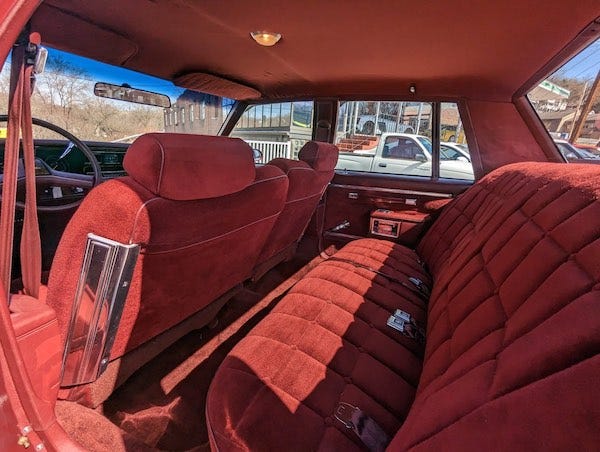
Thanks for reading Willoughby Hills! Subscribe for free to receive new posts and support my work.
Related Reading
If you’ve missed past issues of this newsletter, they are available to read here.


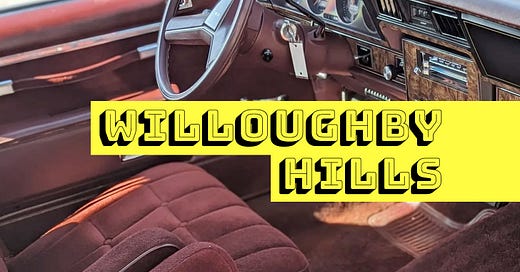


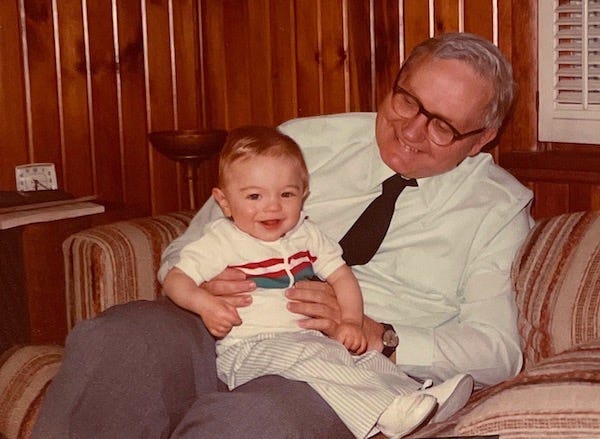
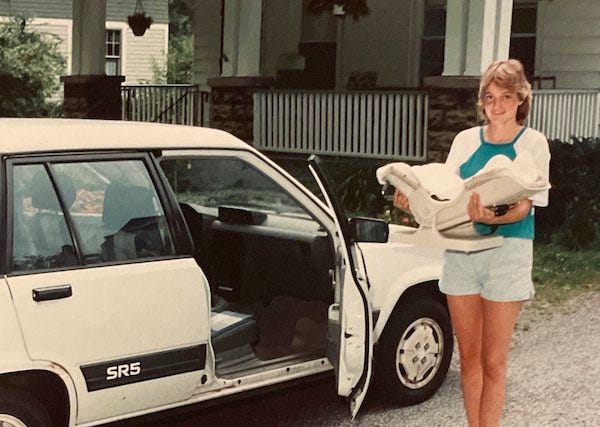
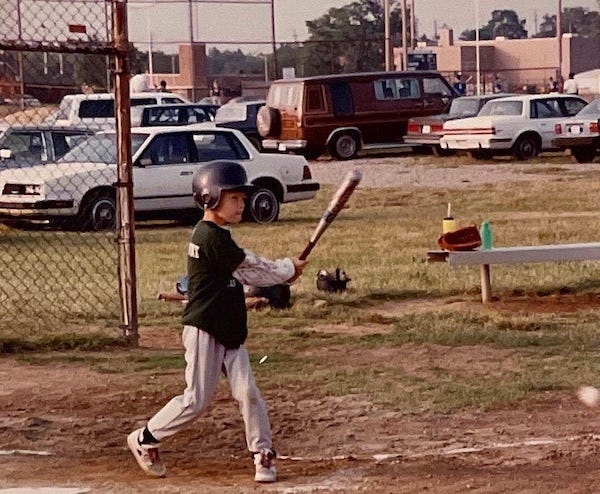
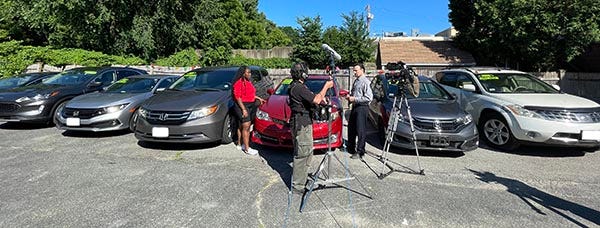
What a great story...I went down memory lane as I read this. Cars have always been an important part of my 80 years. I dated first husband in a big 1949 Buick. Note..big front seat so I could slide over close to him.
In my parking lot at work, there are 2 cars similar make, model, color as mine. And then 3 others similar make, model, color. All 6 are foreign, "small" SUVs. And there are only at most 12 cars in our employee parking area every day.
On another note, my son gifted me a framed ad depicting our make, model, color of the car the kids grew up with. A '91 black Ford Escort sport. I just hung it on the wall yesterday. Americans. We love our cars.